Novel Alkali-Activated Materials with Photocatalytic and Bactericidal Properties Based on Ceramic Tile Waste
Abstract
:1. Introduction
2. Materials and Methods
2.1. Materials
2.2. Preparation of Alkali-Activated Materials
2.3. Characterization Techniques
- The average particle size of the CW precursor was determined using a Mastersizer 2000 laser granulometer (Malvern Instrument, Malvern, UK). The density of the CW raw material was determined by the pycnometer technique, following ASTM standard C127-04. The chemical composition of the CW and glass waste was determined with an Axios mAX sequential wavelength-dispersive X-ray fluorescence (WDXRF) spectrometer (PANalytical, Tollerton, UK) equipped with a rhodium tube and operated with a maximum power of 4.0 kW with SuperQ software version 5.0 L.
- The compressive strengths of the alkali activated materials were obtained according to ASTM C109 using 20 mm cubic specimens. The tests were carried out on an Instron 3369 universal testing machine (Instron, Norwood, MA, USA) at a displacement speed of 1 mm/min. The data reported correspond to the average of the four test specimens.
- The surfaces of the pieces obtained after the mechanical tests were observed with scanning electron microscopy (SEM) using a JEOL JSM-6490LV instrument (JEOL, Tokyo, Japan) with a 20 kV acceleration voltage. The pieces observed had been previously coated with gold, and the observations were made in high vacuum mode (3 × 10−6 torr). An Oxford Instruments Link-Isis X-ray spectrometer (Oxford Instruments, Abingdon, UK) was coupled to the microscope for energy-dispersive spectrometry (EDS).
- X-ray diffraction (XRD) of the CW and pastes was performed using an X’Pert MRD PANalytical (Malvern-PANalytical, Malvern, UK) diffractometer with Cu Kα1 radiation at 20 mA and 40 kV. The samples were scanned at 2θ angles between 5° and 60°, at a step rate of 0.02 and a holding time of 4.0 s per step.
- The physical properties of the pastes as the bulk density, percent absorption, and volume of permeable pores were determined according to ASTM C642, with the modification of leaving the samples submerged in water at 100 °C for 3 h instead of the 5 h specified in the standard for OPC-based materials. The data reported correspond to the average of the three test specimens.
- For the degradation of Rh-B, discs 3 cm in diameter and 4 mm in height were prepared from all pastes with 5 and 10 wt.% of TiO2 particles and ZnO particles. The determination of the photocatalytic activity was evaluated using a method based on that used by [40], performing the immersion of the samples in 10 mL of Rh-B with a concentration of 5 ppm, and using exposure to ultraviolet light for 24 h. UV-A radiation was supplied by two mercury lamps (ELECTROLUX T8 20w/BLB) located inside a black acrylic dome. These lamps emit light at an intensity of 10.3 W·m−2, which was measured with a Delta Ohm HD 2102.2 photoradiometer (Delta Ohm, Caselle, Italy) using the filter for UV-A light with a range of 5 mm. For each measurement, 1 mL aliquot was deposited in 50 mL of distilled water in a Falcon tube for centrifuge, and then a sample was taken and placed into quartz cell of 2 mL. The degradation efficiency after 24 h was monitored at a wavelength of 554 nm using a Shimadzu UV−VIS spectrophotometer (Shimadzu, Columbia, MD, USA), model UV-1800 series A1145450047OCD.
- The biological activity of the materials was evaluated through the inhibition of the bacterial growth [46] of ATCC strains of K. pneumoniae (ATCC® 13883TM) and P. aeruginosa (ATCC® 27853TM) acquired from the ATCC cell bank, similarly to method presented by [46,53,54]. The cylindrical samples (4 cm in diameter and 2 mm thick for pastes and 2.6 cm in diameter for mortars) were exposed to ultraviolet light (λ = 360 nm) for 24 h in a chamber with a lamp at 10.3 Wm−2 intensity prior to the test with bacteria, similar to [54,55]. The antimicrobial activity test on cement mortars irradiated with the UVA light shortened the inactivation time of the bacteria and, additionally, it was possible to compare them with the action of natural daylight [53,54,55]. Afterwards, each bacterial inoculum was added to LB agar at 37 °C, and was homogenized and served in Petri dishes; then, the material to be evaluated (paste or mortar) was placed in the center of the box and left in a flow cabinet until gelling. It was incubated for 18 h at 37 °C. After incubation, each plate was examined and visualized for the presence of colonies grown on the surface of the material or the formation of inhibition halos was registered. The culture medium and supplements used were BHI Broth (Becton Dickinson, Franklin Lakes, NJ, USA), Luria Bertani Agar (Becton Dickinson, Franklin Lakes, NJ, USA), saline solution (Corpaul, Medellín, Colombia), and saline phosphate buffer (Bio-Connect, Huissen, The Netherlands). A Sensi-disc control of gentamicin was used (6 mm in diameter and 2 mm thick).
3. Results and Discussion
3.1. Raw Materials
3.2. Characterization of the CW-OPC Hybrid Pastes
3.3. Effect of TiO2 and ZnO Particles in Mechanical and Photocatalytic Properties
3.4. Biological Activity with Bacteria
4. Conclusions
- The contribution of amorphous and soluble silica from SS is an essential component to achieve compressive strengths in pastes above 10 MPa. A high sodium content in the mixtures reduces the viscosity of the pastes and results in carbonation reactions with the environment, which can generate efflorescence due to carbonated products on the surface of the samples. The formation of the CASH gel and the hybrid N-CASH gel was evidenced by the CW-OPC mixture. The optimal molar ratio values for the preparation of pastes with strengths of 40 MPa at 28 days were 7.7 for SiO2/Al2O3 and 0.12 for Na2O/SiO2.
- In the evaluation of the capacity of alternative silicate formation, the replacement of SS by 50% glass was not beneficial due to the poor dissolution of the glass at room temperature and under the alkaline conditions studied. Additionally, the incorporation of glass as a fine aggregate decreased the compressive strengths. The values obtained were 25.21, 11.57, and 9.08 MPa at 28 days of curing for the MRef mortar (made with river sand), M11-SS mortar, and M11-50SS:50G mortar using G as a fine aggregate, respectively. The loss of strength was attributed to the formation of a weakened aggregate−paste transition zone with a high porosity and the formation of microcracks around the glass aggregate.
- The 100SS-5Z and 50G:50SS-10Ti pastes showed an effective photocatalytic activity for Rh-B degradation, with percentages of Rh-B degradation of 98.4% and 76.4%, respectively, after 24 h, but problems of mixing and poor dispersion of the nanoparticles were observed and could be the main technological challenge.
- The 100SS-5Z and 50G:50SS-10Ti pastes, together with their respective mortars, were effective at inhibiting the growth of P. aeruginosa and K. pneumoniae strains, evidenced by the formation of bacterial inhibition halos around the sample discs.
- These results demonstrated the possibility of using ceramic tile waste in high proportions for the elaboration of new rendering mortar with innovative properties.
Author Contributions
Funding
Institutional Review Board Statement
Informed Consent Statement
Data Availability Statement
Conflicts of Interest
References
- World Green Building Council. Global Status Report 2017|World Green Building Council. 2017. Available online: https://www.worldgbc.org/news-media/global-status-report-2017 (accessed on 11 September 2021).
- Purushotham, K.B.; Chandra Mohan, D.V.; Janardhan Yadav, M.; Naga Ratna Giri, P.S. Comparative studies on LC3 based concrete with OPC & PPC based concretes. Mater. Today Proc. 2021, 43, 2368–2372. [Google Scholar] [CrossRef]
- Batuecas, E.; Ramón-Álvarez, I.; Sánchez-Delgado, S.; Torres-Carrasco, M. Carbon footprint and water use of alkali-activated and hybrid cement mortars. J. Clean. Prod. 2021, 319, 128653. [Google Scholar] [CrossRef]
- Garcés, J.I.T.; Dollente, I.J.; Beltran, A.B.; Tan, R.R.; Promentilla, M.A.B. Life cycle assessment of self-healing geopolymer concrete. Clean. Eng. Technol 2021, 4, 100147. [Google Scholar] [CrossRef]
- Robayo, R.A.; Mejía-Arcila, J.; Mejía de Gutiérrez, R.; Martínez, E. Life cycle assessment (LCA) of an alkali-activated binary concrete based on natural volcanic pozzolan: A comparative analysis to OPC concrete. Constr. Build. Mater. 2018, 176, 103–111. [Google Scholar] [CrossRef]
- Salas, D.A.; Ramirez, A.D.; Ulloa, N.; Baykara, H.; Boero, A.J. Life cycle assessment of geopolymer concrete. Constr. Build. Mater. 2018, 190, 170–177. [Google Scholar] [CrossRef]
- Villaquirán-Caicedo, M.A.; Mejía de Gutiérrez, R. Synthesis of ceramic materials from ecofriendly geopolymer precursors. Mater. Lett. 2018, 230, 300–304. [Google Scholar] [CrossRef]
- Guzmán-Aponte, L.A.; Mejía de Gutiérrez, R.; Maury-Ramírez, A. Metakaolin-Based geopolymer added TiO2 particles: Physicomechanical characteristics. Coatings 2017, 7, 233. [Google Scholar] [CrossRef] [Green Version]
- Dehghani, A.; Aslani, F.; Ghaebi Panah, N. Effects of initial SiO2/Al2O3 molar ratio and slag on fly ash-based ambient cured geopolymer properties. Constr. Build. Mater. 2021, 293, 123527. [Google Scholar] [CrossRef]
- Tayeh, B.A.; Zeyad, A.M.; Agwa, I.S.; Amin, M. Effect of elevated temperatures on mechanical properties of lightweight geopolymer concrete. Case Stud. Constr. Mater. 2021, 15, e00673. [Google Scholar] [CrossRef]
- Khan, M.N.N.; Kuri, J.C.; Sarker, P.K. Effect of waste glass powder as a partial precursor in ambient cured alkali activated fly ash and fly ash-GGBFS mortars. J. Build. Eng. 2020, 34, 101934. [Google Scholar] [CrossRef]
- Joudah, Z.H.; Huseien, G.F.; Samadi, M.; Shukor Lim, N.H.A. Sustainability evaluation of alkali-activated mortars incorporating industrial wastes. Mater. Today Proc. 2021, 45, 1971–1977. [Google Scholar] [CrossRef]
- Villaquirán-Caicedo, M.A. Studying different silica sources for preparation of alternative waterglass used in preparation of binary geopolymer binders from metakaolin/boiler slag. Constr. Build. Mater. 2019, 227, 116621. [Google Scholar] [CrossRef]
- Athira, V.S.; Charitha, V.; Athira, G.; Bahurudeen, A. Agro-waste ash based alkali-activated binder: Cleaner production of zero cement concrete for construction. J. Clean. Prod. 2021, 286, 125429. [Google Scholar] [CrossRef]
- Tefa, L.; Bassani, M.; Coppola, B.; Palmero, P. Strength development and environmental assessment of alkali-activated construction and demolition waste fines as stabilizer for recycled road materials. Constr. Build. Mater. 2021, 289, 123017. [Google Scholar] [CrossRef]
- Ouda, A.S. A preliminary investigation on gamma-rayattenuation of alkali-activated concrete waste based-geopolymer modified with pozzocrete-fly ash. Prog. Nucl. Energy 2021, 134, 103681. [Google Scholar] [CrossRef]
- Das, S.K.; Shrivastava, S. Influence of molarity and alkali mixture ratio on ambient temperature cured waste cement concrete based geopolymer mortar. Constr. Build. Mater. 2021, 301, 124380. [Google Scholar] [CrossRef]
- Hwang, C.L.; Damtie Yehualaw, M.; Vo, D.H.; Huynh, T.P. Development of high-strength alkali-activated pastes containing high volumes of waste brick and ceramic powders. Constr. Build. Mater. 2019, 218, 519–529. [Google Scholar] [CrossRef]
- Robayo, R.A.; Mulford, A.; Munera, J.; Mejía de Gutiérrez, R. Alternative cements based on alkali-activated red clay brick waste. Constr. Build. Mater. 2016, 128, 163–169. [Google Scholar] [CrossRef]
- Sedira, N.; Castro-Gomes, J.; Magrinho, M. Red clay brick and tungsten mining waste-based alkali-activated binder: Microstructural and mechanical properties. Constr. Build. Mater. 2018, 190, 1034–1048. [Google Scholar] [CrossRef]
- Rakhimova, N.R.; Rakhimov, R.Z. Alkali-activated cements and mortars based on blast furnace slag and red clay brick waste. Mater. Des. 2015, 85, 324–331. [Google Scholar] [CrossRef]
- Robayo-Salazar, R.A.; Mattey Centeno, P.E.; Silva Urrego, Y.F.; Burgos Galindo, D.M.; Delvasto, S. Construction and demolition wastes: Analysis of its management and reuse in Cali. Rev. Tecnura 2015, 19, 157–170. [Google Scholar]
- Huseien, G.F.; Sam, A.R.M.; Shah, K.W.; Mirza, J. Effects of ceramic tile powder waste on properties of self-compacted alkali-activated concrete. Constr. Build. Mater. 2020, 236, 117574. [Google Scholar] [CrossRef]
- Murillo, L.M.; Delvasto, S.; Gordillo, M. A study of a hybrid binder based on alkali-activated ceramic tile wastes and Portland cement. In Sustainable and Nonconventional Construction Materials using Inorganic Bonded Fiber Composites; Savastano, H., Fiorelli, J., Dos Santos, S.F., Eds.; Elsevier: Amsterdam, The Netherlands, 2017; pp. 291–311. [Google Scholar]
- Davidovits, J. Properties of geopolymer cements. In First International Conference on Alkaline Cements and Concrete; Kiev State Technical University: Kyiv, Ukraine, 1994; pp. 131–149. Available online: http://www.geopolymer.org/fichiers_pdf/KIEV.pdf (accessed on 3 September 2021).
- Torres-Carrasco, M.; Puertas, F. Alkaline activation of different aluminosilicates as an alternative to Portland cement: Alkali activated cements or geopolymers. Rev. Ing. Constr. 2017, 32, 5–12. [Google Scholar] [CrossRef] [Green Version]
- Ibrahim, M.; Maslehuddin, M. An overview of factors influencing the properties of alkali-activated binders. J. Clean. Prod. 2021, 286, 124972. [Google Scholar] [CrossRef]
- Xiao, R.; Zhang, Y.; Jiang, X.; Polaczyk, P.; Ma, Y.; Huang, B. Alkali-activated slag supplemented with waste glass powder: Laboratory characterization, thermodynamic modelling and sustainability analysis. J. Clean. Prod. 2021, 286, 125554. [Google Scholar] [CrossRef]
- Amorim Júnior, N.S.; Andrade Neto, J.S.; Santana, H.A.; Cilla, M.S.; Ribeiro, D.V. Durability and service life analysis of metakaolin-based geopolymer concretes with respect to chloride penetration using chloride migration test and corrosion potential. Constr. Build. Mater. 2021, 287, 122970. [Google Scholar] [CrossRef]
- Saloni Parveen, Y.Y.; Pham Jatin, T.M.; Kumar, J. Sustainable alkali activated concrete with fly ash and waste marble aggregates: Strength and durability studies. Constr. Build. Mater. 2021, 283, 122795. [Google Scholar] [CrossRef]
- Siddique, S.; Jang, J.G. Acid and sulfate resistance of seawater based alkali activated fly ash: A sustainable and durable approach. Constr. Build. Mater. 2021, 281, 122601. [Google Scholar] [CrossRef]
- Ouda, A.S.; Gharieb, M. Behavior of alkali-activated pozzocrete-fly ash paste modified with ceramic tile waste against elevated temperatures and seawater attacks. Constr. Build. Mater. 2021, 285, 122866. [Google Scholar] [CrossRef]
- Maury, A.; De Belie, N. State of the art of TiO2 containing cementitious materials: Self-cleaning properties. Mater. Construcción 2010, 60, 33–50. [Google Scholar] [CrossRef] [Green Version]
- Haider, A.J.; Al–Anbari, R.H.; Kadhim, G.R.; Salame, C.T. Exploring potential environmental applications of TiO2 nanoparticles. Energy Procedia 2017, 119, 332–345. [Google Scholar] [CrossRef]
- Mohd Adnan, M.A.; Muhd Julkapli, N.; Amir, M.N.I.; Maamor, A. Effect on different TiO2 photocatalyst supports on photodecolorization of synthetic dyes: A review. Int. J. Environ. Sci. Technol. 2019, 16, 547–566. [Google Scholar] [CrossRef]
- Baheiraei, N.; Moztarzadeh, F.; Hedayati, M. Preparation and antibacterial activity of Ag/SiO2 thin film on glazed ceramic tiles by sol-gel method. Ceram. Int. 2012, 38, 2921–2925. [Google Scholar] [CrossRef]
- Drugă, B.; Ukrainczyk, N.; Weise, K.; Koenders, E.; Lackner, S. Interaction between wastewater microorganisms and geopolymer or cementitious materials: Biofilm characterization and deterioration characteristics of mortars. Int. Biodeterior. Biodegrad. 2018, 134, 58–67. [Google Scholar] [CrossRef]
- Abo-El-Enein, S.A.; El-Hosiny, F.I.; El-Gamal, S.M.A.; Amin, M.S.; Ramadan, M. Gamma radiation shielding, fire resistance and physicochemical characteristics of Portland cement pastes modified with synthesized Fe2O3 and ZnO nanoparticles. Constr. Build. Mater. 2018, 173, 687–706. [Google Scholar] [CrossRef]
- Guo, M.Z.; Maury-Ramirez, A.; Poon, C.S. Photocatalytic activities of titanium dioxide incorporated architectural mortars: Effects of weathering and activation light. Build. Environ. 2015, 94, 395–402. [Google Scholar] [CrossRef]
- Zailan, S.N.; Mahmed, N.; Abdullah, M.M.A. Photocatalytic activity of ZnO-doped geopolymer paste. IOP Conf. Ser. Mater. Sci. Eng. 2020, 864, 012038. [Google Scholar] [CrossRef]
- Zailan, S.N.; Mahmed, N.M.; Abdullah, M.M.A. Photocatalytic behaviour of TiO2-geopolymer paste under Sunlight photocatalytic behaviour of TiO2-geopolymer paste under sunlight. IOP Conf. Ser. Mater. Sci. Eng. 2020, 957, 012006. [Google Scholar] [CrossRef]
- Abdel-Gawwad, H.A.; Mohamed, S.A.; Mohammed, M.S. Recycling of slag and lead-bearing sludge in the cleaner production of alkali activated cement with high performance and microbial resistivity. J. Clean. Prod. 2019, 220, 568–580. [Google Scholar] [CrossRef]
- Sikora, P.; Augustyniak, A.; Cendrowski, K.; Nawrotek, P.; Mijowska, E. Antimicrobial activity of Al2O3, CuO, Fe3O4, and ZnO nanoparticles in scope of their further application in cement-based building materials. Nanomaterials 2018, 8, 212. [Google Scholar] [CrossRef] [PubMed] [Green Version]
- Dahiya, M.S.; Tomer, V.K.; Duhan, S. Bioactive glass/glass ceramics for dental applications. In Applications of Nanocomposite Materials in Dentistry; Asiri, A.M., Inamuddin, A.M., Eds.; Elsevier: Amsterdam, The Netherlands, 2018; pp. 1–25. [Google Scholar]
- Hasmaliza, M.; Foo, H.S.; Mohd, K. Anatase as antibacterial material in ceramic tiles. Procedia Chem. 2016, 19, 828–834. [Google Scholar] [CrossRef] [Green Version]
- Mejía de Gutiérrez, R.; Villaquirán-Caicedo, M.A.; Ramírez-Benavides, S.; Astudillo, M.; Mejía, D. Evaluation of the antibacterial activity of a geopolymer mortar based on metakaolin supplemented with TiO2 and CuO particles using glass waste as fine aggregate. Coatings 2020, 10, 157. [Google Scholar] [CrossRef] [Green Version]
- González-Sánchez, J.F.; Taşcı, B.; Fernández, J.M.; Navarro-Blasco, I.; Alvarez, J.I. Improvement of the depolluting and self-cleaning abilities of air lime mortars with dispersing admixtures. J. Clean. Prod. 2021, 292, 126069. [Google Scholar] [CrossRef]
- Kawashima, S.; Seo, J.W.; Corr, D.; Hersam, M.C.; Shah, S.P. Dispersion of CaCO3 nanoparticles by sonication and surfactant treatment for application in fly ash-cement systems. Mater. Struct. Constr. 2014, 47, 1011–1023. [Google Scholar] [CrossRef]
- Nurul Reffa Azyan, N.; Norkhairunnisa, M.; Tay, C.H.; Azmah Hanim, M.A. Techniques on dispersion of nanoparticles in polymer matrices: A review. Pertanika J. Sci. Technol. 2017, 25, 1073–1084. [Google Scholar]
- Maury-Ramirez, A.; de Belle, N. Application of TiO2 photocatalysis to cementitious materials for self-cleaning purposes. In Application of Titanium Dioxide Photocatalysis to Construction Materials; Ohama, Y., van Gemert, D., Eds.; Springer: Dordrecht, The Netherlands, 2011; pp. 11–15. [Google Scholar]
- Mejía de Gutiérrez, R.; Villaquirán-Caicedo, M.A.; Guzmán-Aponte, L. Alkali-activated metakaolin mortars using glass waste as fine aggregate: Mechanical and photocatalytic properties. Constr. Build. Mater. 2020, 235, 117510. [Google Scholar] [CrossRef]
- Syamsidar, D.; Nurfadilla; Subaer. The properties of nano TiO2-geopolymer composite as a material for functional surface application. MATEC Web Conf. 2017, 97, 01013. [Google Scholar] [CrossRef] [Green Version]
- Sikora, P.; Augustyniak, A.; Cendrowski, K.; Horszczaruk, E.; Rucinska, T.; Nawrotek, P.; Mijowska, E. Characterization of mechanical and bactericidal properties of cement mortars containing waste glass aggregate and nanomaterials. Materials 2016, 9, 701. [Google Scholar] [CrossRef] [Green Version]
- Loh, K.; Gaylarde, C.C.; Shirakawa, M.A. Photocatalytic activity of ZnO and TiO2 nanoparticles for use in cement mixes. Constr. Build. Mater. 2018, 167, 853–859. [Google Scholar] [CrossRef]
- Yemmireddy, V.K.; Hung, Y.C. Effect of binder on the physical stability and bactericidal property of titanium dioxide (TiO2) nanocoatings on food contact surfaces. Food Control 2015, 57, 82–88. [Google Scholar] [CrossRef] [Green Version]
- Noman, M.T.; Amor, N.; Petru, M.; Mahmood, A.; Kejzlar, P. Photocatalytic behaviour of zinc oxide nanostructures on surface activation of polymeric fibres. Polymers 2021, 13, 1227. [Google Scholar] [CrossRef]
- Jiang, X.; Manawan, M.; Feng, T.; Zhao, T.; Zhou, G.; Kong, F.; Wang, Q.; Dai, S.; Pan, J.H. Anatase and rutile in evonik aeroxide P25: Heterojunctioned or individual nanoparticles? Catal. Today 2016, 300, 12–17. [Google Scholar] [CrossRef]
- Zhang, T.; Li, K.; Pan, J.H. Annealing temperature-dependent electrochemical properties of Aeroxide P25 TiO2 nanoparticles as anode material for lithium storage. Prog. Nat. Sci. Mater. Int. 2019, 29, 679–684. [Google Scholar] [CrossRef]
- Huang, G.; Yang, H.; Sun, Y.; Lu, Z.; Zhang, X.; Zuo, L.; Feng, Y.; Qian, R.; Qi, Y.; Ji, Y.; et al. Influence of NaOH content on the alkali conversion mechanism in MSWI bottom ash alkali-activated mortars. Constr. Build. Mater. 2020, 248, 118582. [Google Scholar] [CrossRef]
- Bignozzi, M.C.; Manzi, S.; Natali, M.E.; Rickard, W.D.; Van Riessen, A. Room temperature alkali activation of fly ash: The effect of Na2O/SiO2 ratio. Constr. Build. Mater. 2014, 69, 262–270. [Google Scholar] [CrossRef]
- Bocullo, V.; Vitola, L.; Vaiciukyniene, D.; Kantautas, A.; Bajare, D. The influence of the SiO2/Na2O ratio on the low calcium alkali activated binder based on fly ash. Mater. Chem. Phys. 2021, 258, 123846. [Google Scholar] [CrossRef]
- Cheng, H.; Lin, K.L.; Cui, R.; Hwang, C.L.; Chang, Y.M.; Cheng, T. The effects of SiO2/Na2O molar ratio on the characteristics of alkali-activated waste catalyst–metakaolin based geopolymers. Constr. Build. Mater. 2015, 95, 710–720. [Google Scholar] [CrossRef]
- Carvalho, R.; Silva, R.V.; de Brito, J.; Pereira, M.F.C. Alkali activation of bottom ash from municipal solid waste incineration: Optimization of NaOH- and Na2SiO3-based activators. J. Clean. Prod. 2021, 291, 125930. [Google Scholar] [CrossRef]
- Sata, V.; Chindaprasirt, P. Use of construction and demolition waste (CDW) for alkali-activated or geopolymer concrete. In Advances in Construction and Demolition Waste Recycling; Pacheco-Torgal, F., Ding, Y., Koutamanis, A., Eds.; Elsevier: Amsterdam, The Netherlands, 2020; pp. 385–403. [Google Scholar]
- Shah, K.W.; Huseien, G.F. Bond strength performance of ceramic, fly ash and GBFS ternary wastes combined alkali-activated mortars exposed to aggressive environments. Constr. Build. Mater. 2020, 251, 119088. [Google Scholar] [CrossRef]
- Hanjitsuwan, S.; Injorhor, B.; Phoo-ngernkham, T.; Damrongwiriyanupap, N.; Li, L.-Y.; Sukontasukkul, P.; Chindaprasirt, P. Drying shrinkage, strength and microstructure of alkali-activated high-calcium fly ash using FGD-gypsum and dolomite as expansive additive. Cem. Concr. Compos. 2020, 114, 103760. [Google Scholar] [CrossRef]
- Villaquirán-Caicedo, M.A.; Mejía de Gutiérrez, R. Comparison of different activators for alkaline activation of construction and demolition wastes. Constr. Build. Mater. 2021, 281, 122599. [Google Scholar] [CrossRef]
- Kamath, M.; Prashant, S.; Kumar, M. Micro-characterisation of alkali activated paste with fly ash-GGBS-metakaolin binder system with ambient setting characteristics. Constr. Build. Mater. 2021, 277, 122323. [Google Scholar] [CrossRef]
- Torres-Carrasco, M.; Puertas, F. Waste glass as a precursor in alkaline activation: Chemical process and hydration products. Constr. Build. Mater. 2017, 139, 342–354. [Google Scholar] [CrossRef]
- Garcia-Lodeiro, I.; Palomo, A.; Fernández-Jiménez, A.; MacPhee, D.E. Compatibility studies between N-A-S-H and C-A-S-H gels. Study in the ternary diagram Na2O-CaO-Al2O3-SiO2-H2O. Cem. Concr. Res. 2011, 41, 923–931. [Google Scholar] [CrossRef]
- Cristelo, N.; Fernández-Jiménez, A.; Vieira, C.; Miranda, T.; Palomo, A. Stabilisation of construction and demolition waste with a high fines content using alkali activated fly ash. Constr. Build. Mater. 2018, 170, 26–39. [Google Scholar] [CrossRef]
- Tchakouté, H.K.; Rüscher, C.H.; Kong, S.; Kamseu, E.; Leonelli, C. Geopolymer binders from metakaolin using sodium waterglass from waste glass and rice husk ash as alternative activators: A comparative study. Constr. Build. Mater. 2016, 114, 276–289. [Google Scholar] [CrossRef]
- Panizza, M.; Natali, M.; Garbin, E.; Ducman, V.; Tamburini, S. Optimization and mechanical-physical characterization of geopolymers with Construction and Demolition Waste (CDW) aggregates for construction products. Constr. Build. Mater. 2020, 264, 120158. [Google Scholar] [CrossRef]
- Kuenzel, C.; Vandeperre, L.J.; Donatello, S.; Boccaccini, A.R.; Cheeseman, C. Ambient temperature drying shrinkage and cracking in metakaolin-based geopolymers. J. Am. Ceram. Soc. 2012, 95, 3270–3277. [Google Scholar] [CrossRef] [Green Version]
- Mendes, B.C.; Pedroti, L.G.; Vieira, C.M.; Marvilla, M.; Azevedo, A.R.G.; de Carvalho, J.M.F.; Ribeiro, J.C.L. Application of eco-friendly alternative activators in alkali-activated materials: A review. J. Build. Eng. 2021, 35, 102010. [Google Scholar] [CrossRef]
- Yip, C.K.; Van Deventer, J.S.J. Microanalysis of calcium silicate hydrate gel formed within a geopolymeric binder. J. Mater. Sci. 2003, 38, 3851–3860. [Google Scholar] [CrossRef]
- Aouan, B.; Alehyen, S.; Fadil, M.; El Alouani, M.; Khabbazi, A.; Atbir, A.; Taibi, M. Compressive strength optimization of metakaolin-based geopolymer by central composite design. Chem. Data Collect. 2021, 31, 100636. [Google Scholar] [CrossRef]
- Ling, T.C.; Poon, C.S. Properties of architectural mortar prepared with recycled glass with different particle sizes. Mater. Des. 2011, 32, 2675–2684. [Google Scholar] [CrossRef]
- Arias-Erazo, J.; Villaquirán-Caicedo, M.A.; Goyes, C.E. Ecological light transmiting concrete made from glass waste and acrylic sheets. Constr. Build. Mater. 2021, 304, 124644. [Google Scholar] [CrossRef]
- Nahi, S.; Leklou, N.; Khelidj, A.; Oudjit, M.N.; Zenati, A. Properties of cement pastes and mortars containing recycled green glass powder. Constr. Build. Mater. 2020, 262, 120875. [Google Scholar] [CrossRef]
- Sasui, S.; Kim, G.; Nam, J.; van Riessen, A.; Hadzima-Nyarko, M. Effects of waste glass as a sand replacement on the strength and durability of fly ash/GGBS based alkali activated mortar. Ceram. Int. 2021, 47, 21175–21196. [Google Scholar] [CrossRef]
- Strini, A.; Roviello, G.; Ricciotti, L.; Ferone, C.; Messina, F.; Schiavi, L.; Corsaro, D.; Cioffi, R. TiO2-based photocatalytic geopolymers for nitric oxide degradation. Materials 2016, 9, 513. [Google Scholar] [CrossRef]
- Macphee, D.E.; Folli, A. Photocatalytic concretes—The interface between photocatalysis and cement chemistry. Cem. Concr. Res. 2016, 85, 48–54. [Google Scholar] [CrossRef]
- Wang, L.; Hu, C.; Shao, L. The antimicrobial activity of nanoparticles: Present situation and prospects for the future. Int. J. Nanomed. 2017, 12, 1227–1249. [Google Scholar] [CrossRef] [Green Version]
- Speziale, A.; Gonzáles-Sánchez, B.; Tasci, B.; Pastor, A.; Sánchez, L.; Fernández-Acevedo, C.; Oroz-Mateoc Lurederra Tech, T.; Salazar, C.; Navarro-Blasco, I.; Fernández, J.M.; et al. Development of multifunctional coatings for protecting stones and lime mortars of the architectural heritage. Int. J. Archit. Herit. 2020, 14, 1008–1029. [Google Scholar] [CrossRef] [Green Version]
- Wang, D.; Hou, P.; Zhang, L.; Yang, P.; Cheng, X. Photocatalytic and hydrophobic activity of cement-based materials from benzyl-terminated-TiO2 spheres with core-shell structures. Constr. Build. Mater. 2017, 148, 176–183. [Google Scholar] [CrossRef]
- Sanalkumar, K.; Yang, E. Self-cleaning performance of nano-TiO2 modified metakaolin-based geopolymers. Cem. Concr. Compos. 2020, 115, 103847. [Google Scholar] [CrossRef]
- Liao, D.L.; Wu, G.S.; Liao, B.Q. Zeta potential of shape-controlled TiO2 nanoparticles with surfactants. Colloids Surf. Physicochem. Eng. Asp. 2009, 348, 270–275. [Google Scholar] [CrossRef]
- Marsalek, R. Particle size and zeta potential of ZnO. APCBEE Procedia 2014, 9, 13–17. [Google Scholar] [CrossRef] [Green Version]
- Chen, J.; Shi-cong, K.; Poon, C. Photocatalytic cement-based materials: Comparison of nitrogen oxides and toluene removal potentials and evaluation of self-cleaning performance. Build. Environ. 2011, 46, 1827–1833. [Google Scholar] [CrossRef]
- Dizaj, S.M.; Lotfipour, F.; Barzegar-Jalali, M.M.; Zarrintan, H.; Adibkia, K. Antimicrobial activity of the metals and metal oxide nanoparticles. Mater. Sci. Eng. C 2014, 44, 278–284. [Google Scholar] [CrossRef] [PubMed]
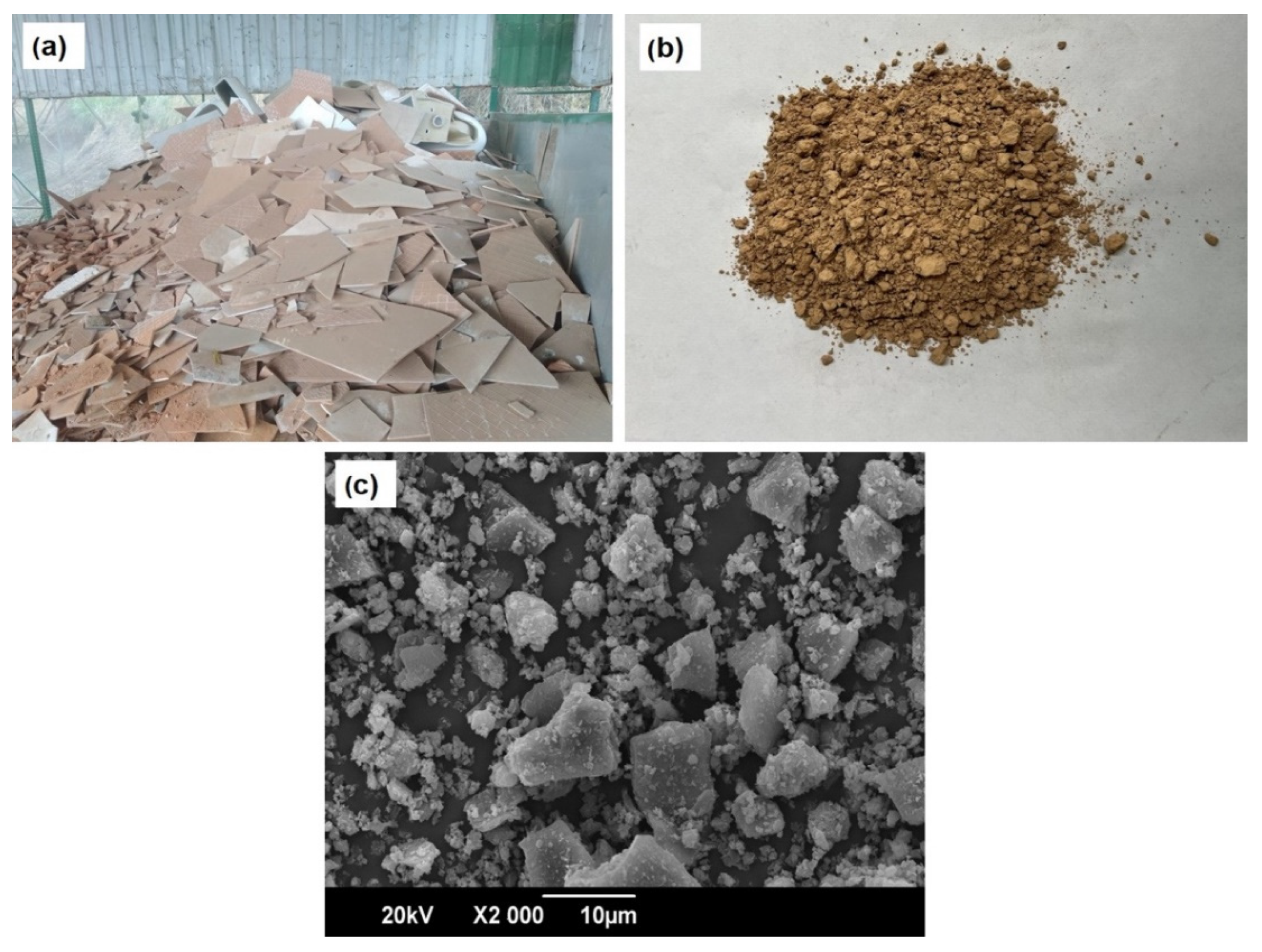
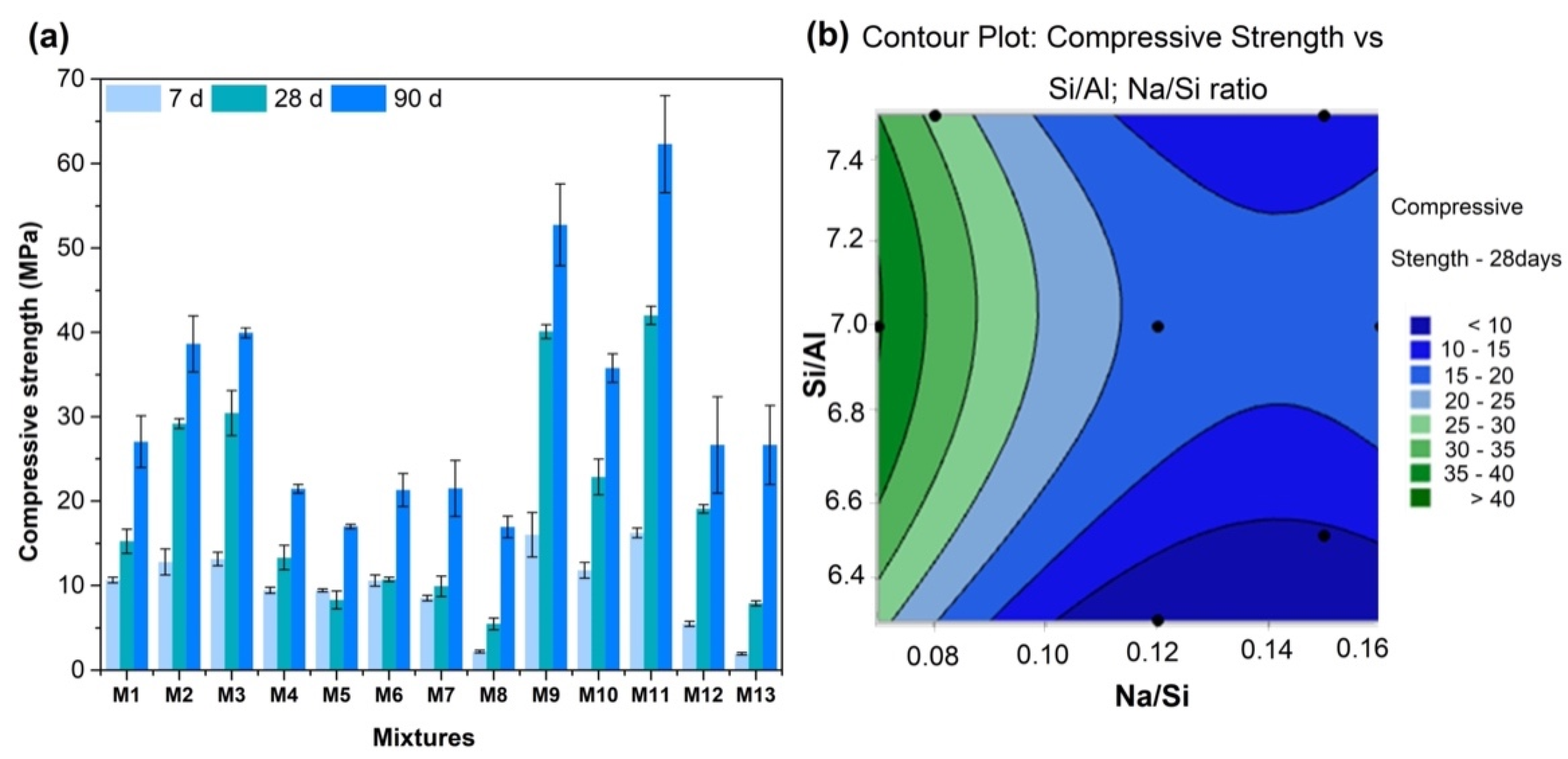
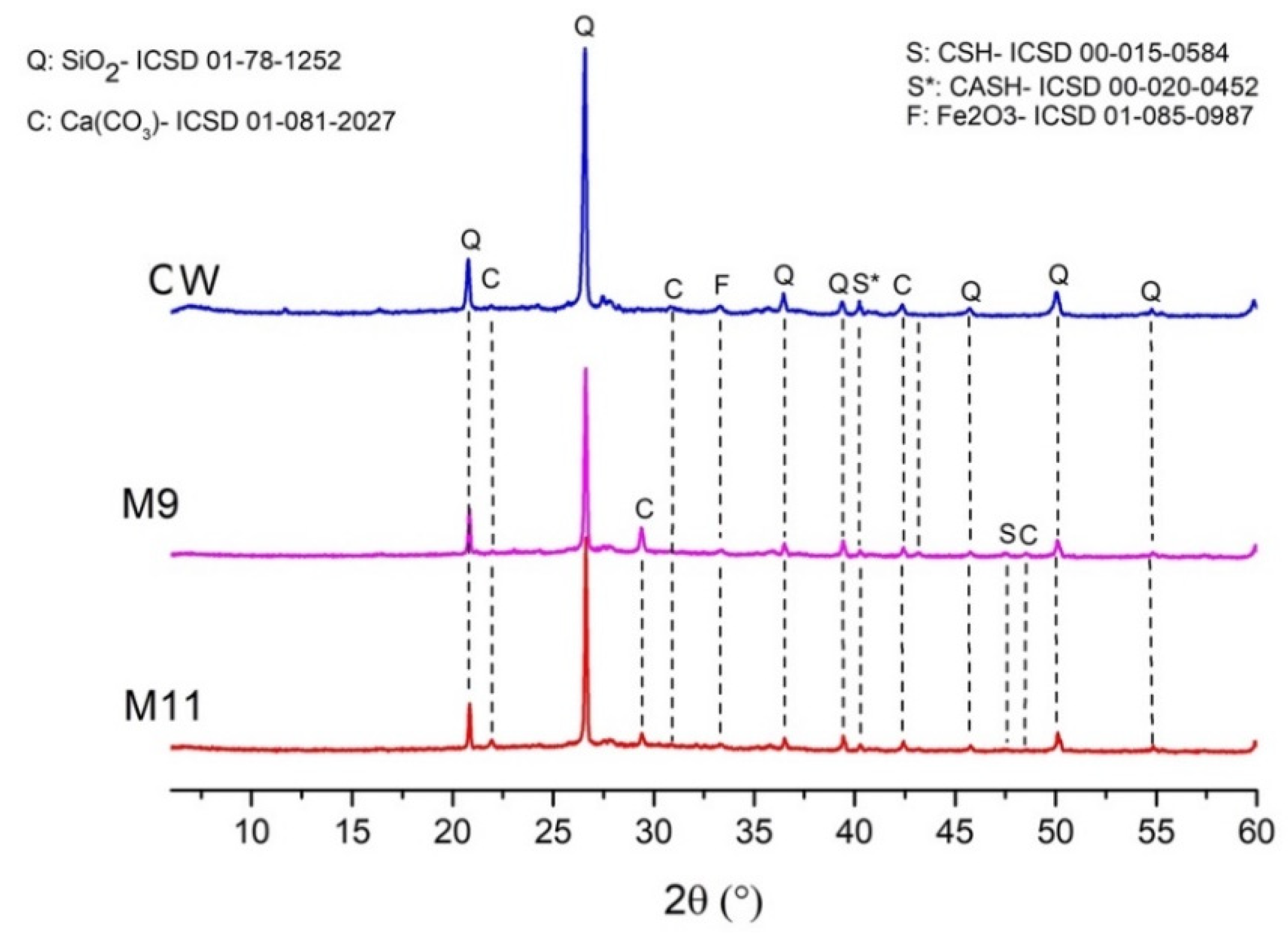
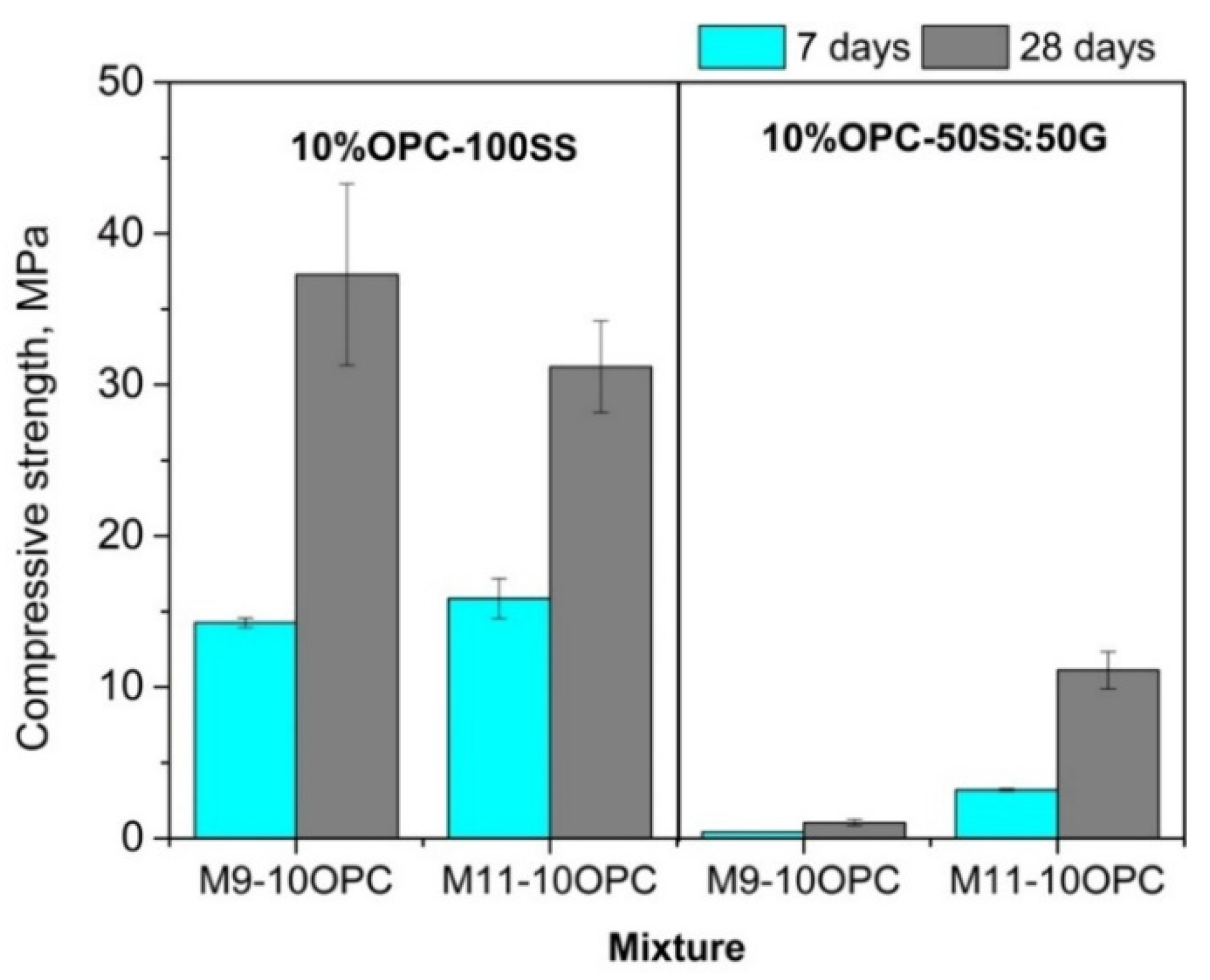
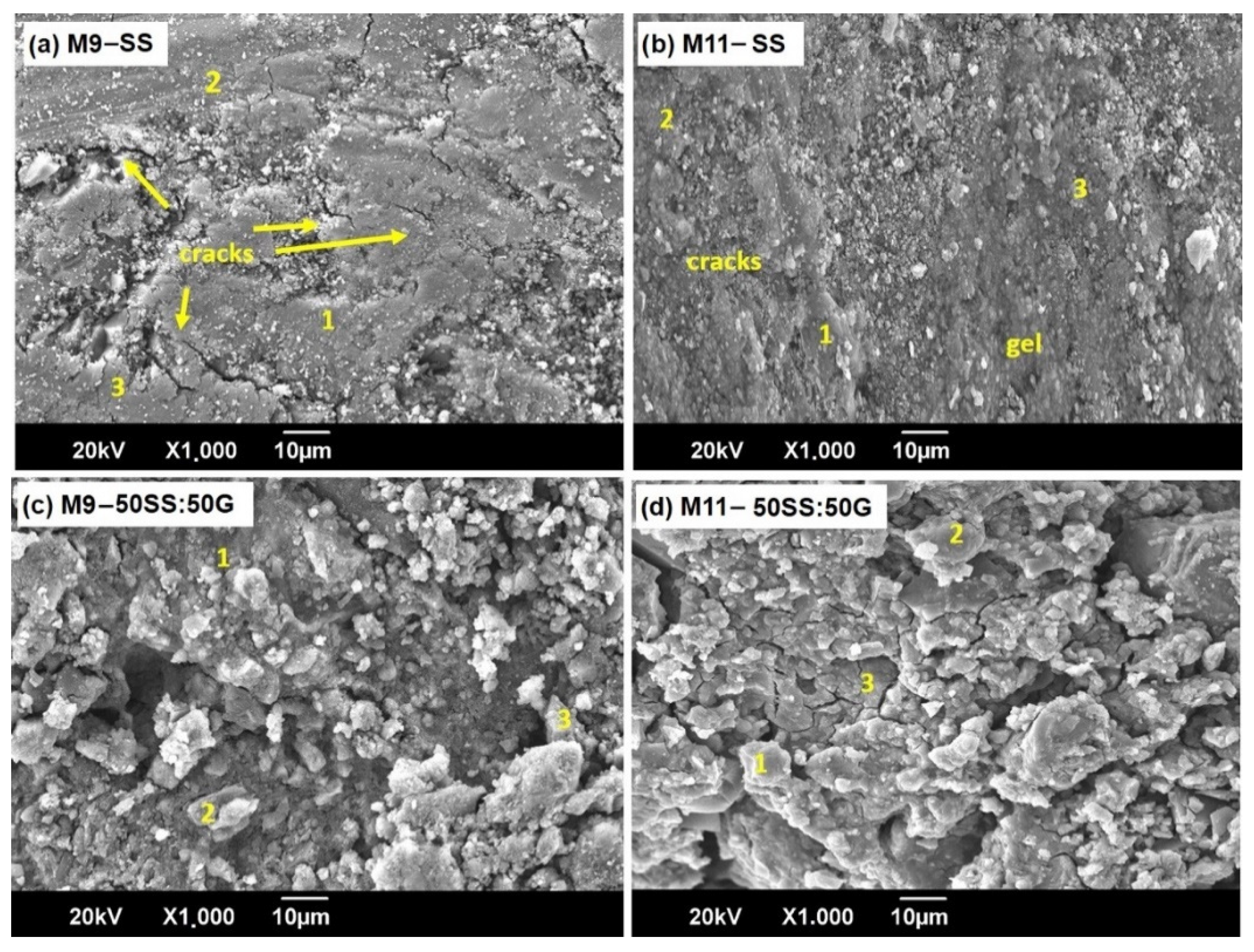
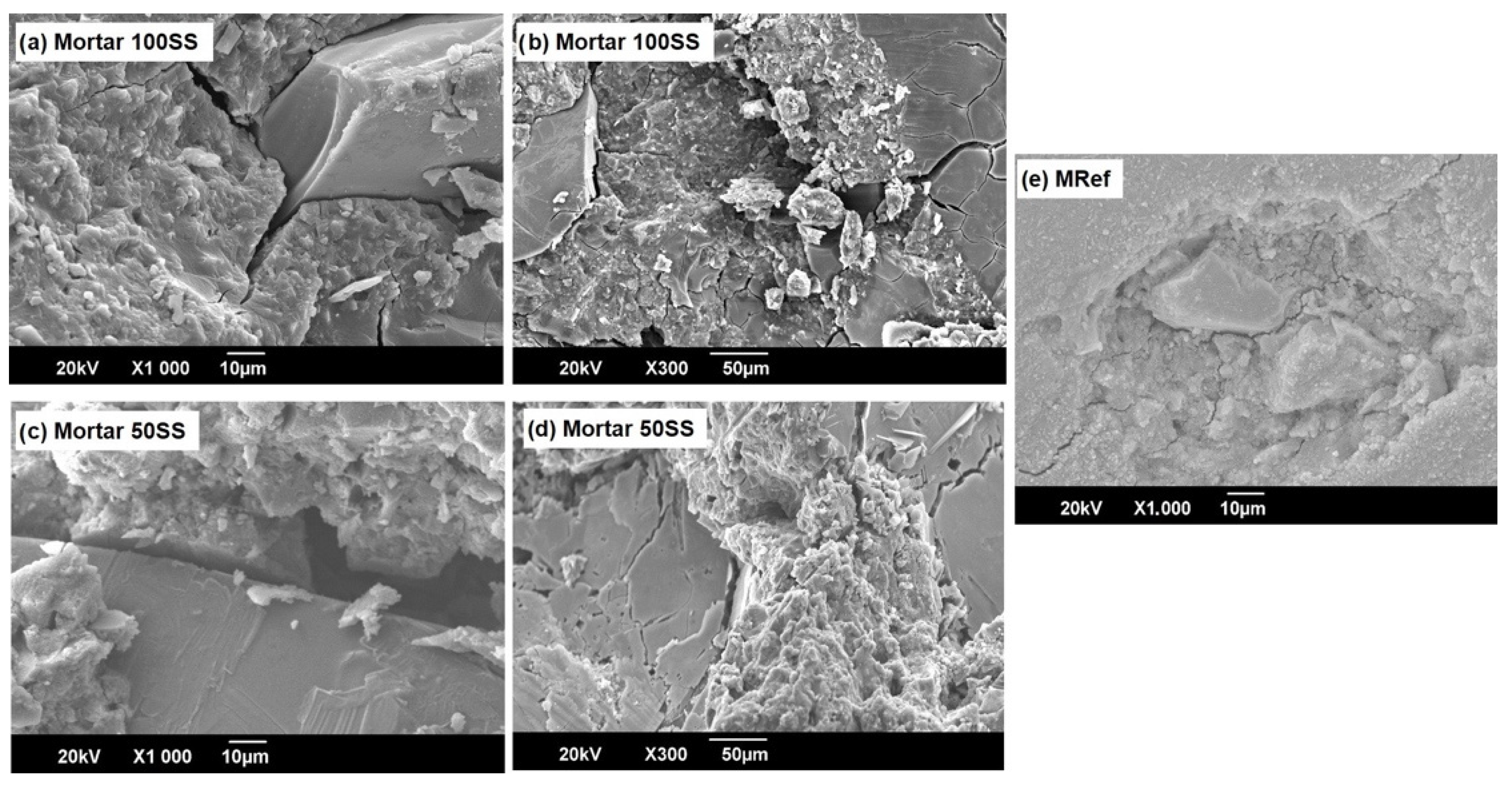

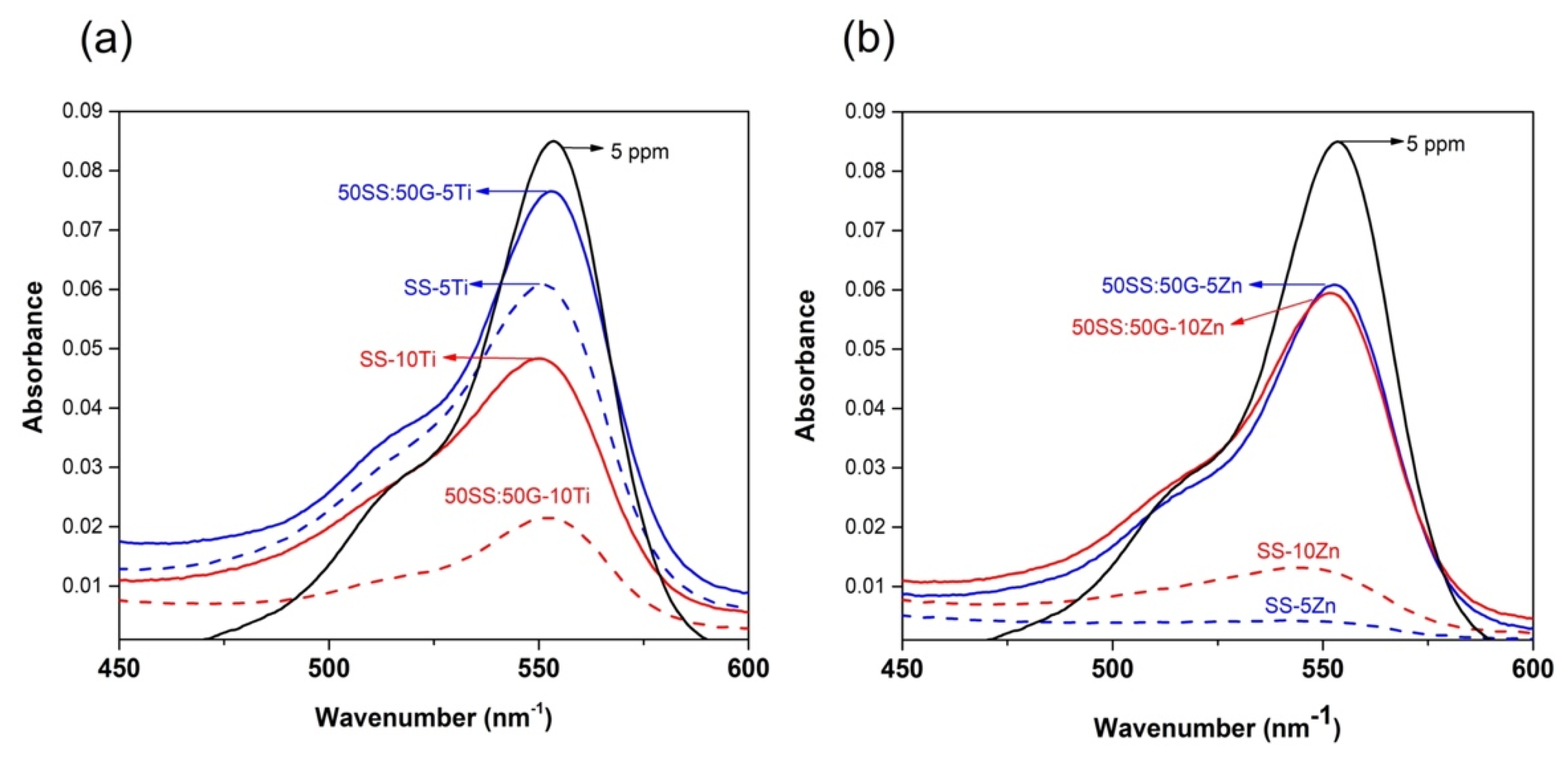

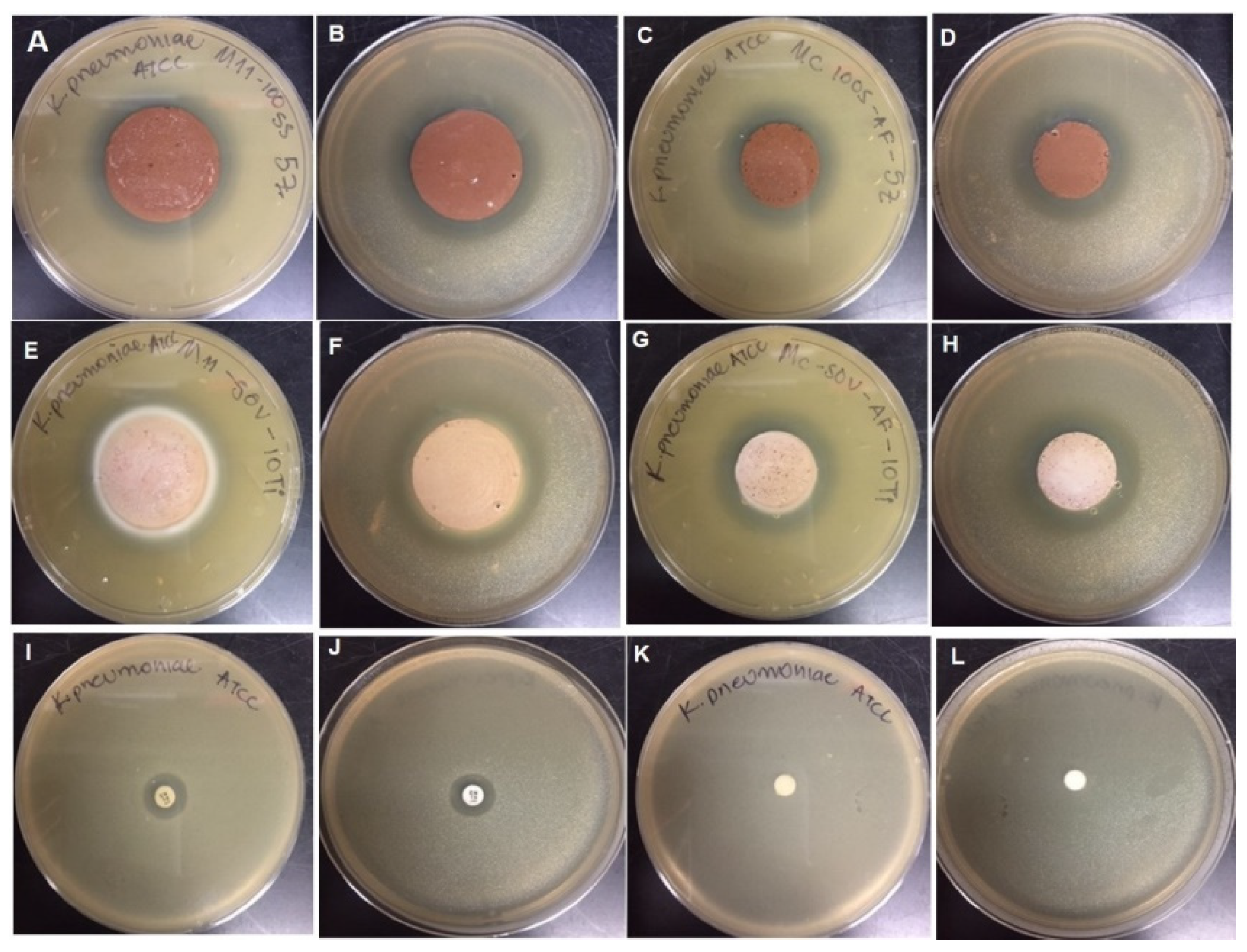
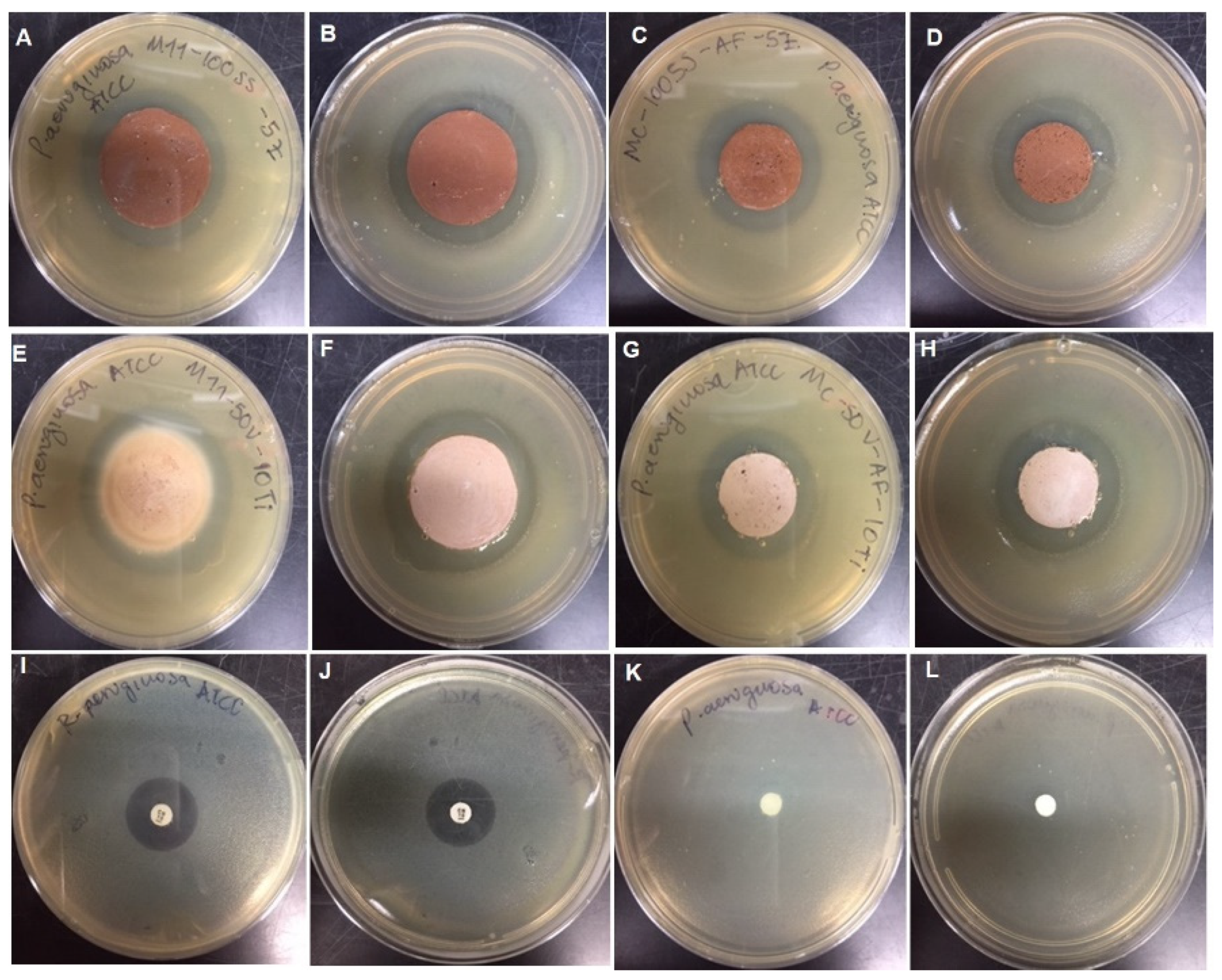
| Mixture | Molar Ratio Na2O/SiO2 | Molar Ratio SiO2/Al2O3 | Molar Ratio NaOH/1 SiO2 |
|---|---|---|---|
| M1 | 0.12 | 7 | 2.87 |
| M2 | 0.08 | 7.5 | 0.48 |
| M3 | 0.12 | 7 | 2.87 |
| M4 | 0.12 | 7 | 2.87 |
| M5 | 0.08 | 6.5 | 5.77 |
| M6 | 0.15 | 7.5 | 2.10 |
| M7 | 0.12 | 7 | 2.87 |
| M8 | 0.12 | 6.3 | 32.05 |
| M9 | 0.07 | 7 | 1.10 |
| M10 | 0.12 | 7 | 2.87 |
| M11 | 0.12 | 7.7 | 1.10 |
| M12 | 0.16 | 7 | 4.28 |
| M13 | 0.15 | 6.5 | 12.04 |
| Compounds | CW | OPC | Glass Waste |
|---|---|---|---|
| (wt.%) | |||
| SiO2 | 70.6 | 17.9 | 72.27 |
| Al2O3 | 19.3 | 3.90 | 1.49 |
| Fe2O3 | 4.3 | 4.80 | 0.62 |
| Na2O | - | 0.20 | 13.37 |
| K2O | 2.4 | 0.30 | 0.51 |
| CaO | 2.0 | 62.30 | 11.15 |
| MgO | 0.8 | 1.80 | 0.26 |
| LOI, 1000 °C | 0.6 | 4.10 | 1.46 |
| Paste | Spectrum | C | O | Na | Al | Si | K | Ca | Fe | Ca/Si Ratio | Interpretation |
|---|---|---|---|---|---|---|---|---|---|---|---|
| M9-100SS | 1 | 25.59 | 28.41 | 2.59 | 11.86 | 25.59 | 1.31 | 1.72 | 2.93 | 0.06 | N(C)–A–S–H, CaCO3, |
| 2 | 27.86 | 39.25 | 2.86 | 9.90 | 14.76 | 0.69 | 1.58 | 3.09 | 0.10 | N(C)–A–S–H, CaCO3, | |
| 3 | 25.80 | 31.60 | 3.78 | 6.97 | 24.06 | 1.23 | 4.70 | 1.86 | 0.19 | (N),C–A–S–H, CaCO3 | |
| M11-100SS | 1 | 41.33 | 24.24 | 2.62 | 4.33 | 20.03 | 1.67 | 5.78 | - | 0.29 | (N),C–A–S–H, CaCO3 |
| 2 | 34.40 | 19.74 | 2.35 | 9.59 | 29.04 | - | 4.88 | - | 0.17 | (N),C–A–S–H, CaCO3 | |
| 3 | - | 25.50 | - | 4.14 | 20.57 | - | 49.78 | - | 2.42 | C–(A)–S–H, portlandite | |
| M9-50SS:50G | 1 | 11.62 | 45.68 | 10.36 | 1.67 | 25.47 | - | 5.21 | - | 0.20 | N,(C)–A–S–H, Na2CO3 |
| 2 | 14.27 | 32.81 | 6.91 | 2.92 | 19.33 | 1.38 | 19.90 | 2.49 | 1.02 | (N),C–A–S–H, (Ca,Na)CO3 | |
| 3 | 16.74 | 44.93 | 10.85 | 3.84 | 18.94 | 1.31 | 2.32 | 1.06 | 0.12 | N,(C)–A–S–H, Na2CO3 | |
| M11-50SS:50G | 1 | 15.95 | 45.22 | 1.44 | 2.19 | 34.41 | 0.79 | - | 0.03 | N,(C)–A–S–H, Na2CO3 | |
| 2 | 21.58 | 40.22 | 4.73 | 6.38 | 23.21 | 0.87 | 1.50 | 1.51 | 0.07 | N,(C)–A–S–H, Na2CO3 | |
| 3 | 12.34 | 48.56 | 10.32 | 4.79 | 17.25 | 1.06 | 3.75 | 1.93 | 0.22 | N,(C)–A–S–H, Ca,Na2CO3 |
| Mixture | Dry Density, kg/m3 | Apparent Density, kg/m3 | Porosity, % | Water Absorption, % |
|---|---|---|---|---|
| M9 | 1820 ± 10 | 2520 ± 10 | 28 ± 0.38 | 15.3 ± 0.2 |
| M11 | 1870 ± 20 | 2430 ± 10 | 23 ± 0.36 | 12.2 ± 0.2 |
| Mixtures | Density, kg/m3 | ||||
|---|---|---|---|---|---|
| 0% | 5%-TiO2 | 10%-TiO2 | 5%-ZnO | 10%-ZnO | |
| M11-SS | 1870 ± 20 | 1880 ± 10 | 1900 ± 10 | 1920 ± 10 | 1970 ± 10 |
| M11-50SS:50G | - | 1990 ± 10 | 2040 ± 20 | 2040 ± 30 | 2040 ± 20 |
| Mixture | C/Co after 24 h | Degradation of RhB, % |
|---|---|---|
| SS-5Ti | 3.4 | 32,4% |
| SS-10Ti | 2.8 | 44.5% |
| 50SS:50G-5Ti | 4.1 | 17.0% |
| 50SS:50G-10Ti | 1.2 | 76.4% |
| SS-5Z | 0.1 | 98.4% |
| SS-10Z | 0.4 | 91.8% |
| 50SS:50G-5Z | 2.0 | 61.0% |
| 50SS:50G-10Zn | 1.9 | 62.1% |
| Type | Mixture | Formation of Bacterial Inhibition Halos | |
|---|---|---|---|
| K. pneumoniae ATCC | P. aeruginosa ATCC | ||
| Mortar | 50SS:50G-10Ti-G | Yes | Yes |
| 100SS-5Z-G | Yes | Yes | |
| Paste | 100SS-5Z | Yes | Yes |
| 50SS:50G-10Ti | Yes | Yes | |
| Control | Sensidisc Gentamicin | Yes | Yes |
| Sensidisc whithout antibiotic | No | No | |
Publisher’s Note: MDPI stays neutral with regard to jurisdictional claims in published maps and institutional affiliations. |
© 2021 by the authors. Licensee MDPI, Basel, Switzerland. This article is an open access article distributed under the terms and conditions of the Creative Commons Attribution (CC BY) license (https://creativecommons.org/licenses/by/4.0/).
Share and Cite
Bonilla, A.; Villaquirán-Caicedo, M.A.; Mejía de Gutiérrez, R. Novel Alkali-Activated Materials with Photocatalytic and Bactericidal Properties Based on Ceramic Tile Waste. Coatings 2022, 12, 35. https://doi.org/10.3390/coatings12010035
Bonilla A, Villaquirán-Caicedo MA, Mejía de Gutiérrez R. Novel Alkali-Activated Materials with Photocatalytic and Bactericidal Properties Based on Ceramic Tile Waste. Coatings. 2022; 12(1):35. https://doi.org/10.3390/coatings12010035
Chicago/Turabian StyleBonilla, Ashley, Mónica A. Villaquirán-Caicedo, and Ruby Mejía de Gutiérrez. 2022. "Novel Alkali-Activated Materials with Photocatalytic and Bactericidal Properties Based on Ceramic Tile Waste" Coatings 12, no. 1: 35. https://doi.org/10.3390/coatings12010035
APA StyleBonilla, A., Villaquirán-Caicedo, M. A., & Mejía de Gutiérrez, R. (2022). Novel Alkali-Activated Materials with Photocatalytic and Bactericidal Properties Based on Ceramic Tile Waste. Coatings, 12(1), 35. https://doi.org/10.3390/coatings12010035







